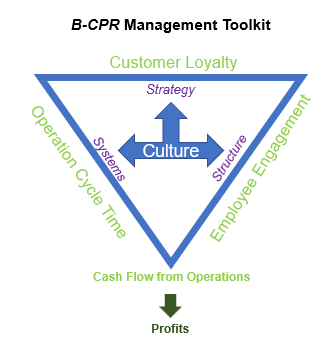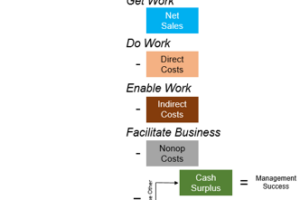
You either know how to identify and do what needs to be done to make more money or don’t. The BusinessCPR™ Management Toolkit gives you ready access to different tools you can use to solve specific business problems. Its purpose is to help you make more money as measured by the growing cash reserves you have in the bank.
Overview
The BusinessCPR™ Management Toolkit has been created to help management teams make planned profits. The driving purpose of the toolkit is to continuously position management teams with the ability to perform the following each month confidently:
- Practice effective cash management and gross profit maximization through personal follow-through on commitments and improved communications that help our employees understand the “score of our game” by job, product, profit center, and month.
- Continuously evaluate business performance by interpreting data and metrics to determine progress in attaining company objectives, then make the necessary change in actions through a strong sense of shared personal accountability for the results being produced.
- Update as needed company financial goals, objectives, and operating budgets to maximize company profitability, then manage these budgets to ensure resources are appropriately allocated to realize company goals and objectives.
The model shown above is how you take your business to the next level once you have mastered STEPS 1 through 5 of the Business CPR™ Management System. Each element of the model, as reflected below, has a series of corresponding tools to help you improve your business profit performance:
Profits: a lagging indicator of the success generated from past decisions.
Culture: defines what is acceptable or unacceptable, important or unimportant, right or wrong, workable or unworkable.
Interior: management controls created through
-
-
- Strategy – identifies company direction, including mile markers (metrics) to know when you arrive
- Structure – organization of assets (people + equipment) to execute the strategy
- Processes – defined series of actions or steps taken to achieve a particular end
-
Exterior: leading indicators that measure and predict results
-
-
- Customer Loyalty – the result of a consistently positive emotional experience, physical attribute-based satisfaction, and perceived value of your customer’s experience with your product and services.
- Employee Engagement – the emotional commitment the employee has to the organization and its goals. Emotional commitment means engaged employees are caring about their work and their company.
- Operation Cycle Time – the period required to complete one cycle of an operation, a function, job, or task from start to finish.
-
At its core, profitable business management comes down to being more proactive and less reactive in managing the cash flowing through your business. Following the flow of money through your business tells you when and where management action is needed to ensure your operations are making and holding onto the money they should be.
